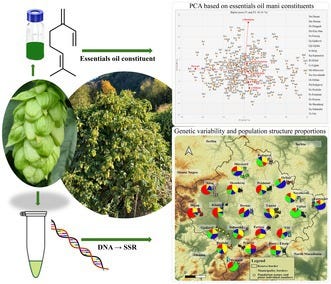Beyond Brewing: Terpene and Genetic Variation of Wild Hops
Research from the Quave (Emory Univ.) and Hajdari (Univ. Prishtina) labs finds that Kosovo’s wild hop populations harbor rich chemical and genetic variation with conservation and crop potential.
In the world of beer, hops (scientific name: Humulus lupulus L., Cannabaceae) are prized for their bitter bite and floral aroma. But for ethnobotanists, hops tells another story; it is a plant with deep cultural roots, complex chemistry, and medicinal value. In Kosovo, hops grow wild along riverbanks and forest edges, long used in folk medicine to calm nerves and ease inflammation. Yet until recently, their chemical and genetic diversity remained uncharted. A new study led by researchers from my lab and the herbarium at Emory University (Atlanta, GA, USA) and collaborators at the University of Prishtina (Prishtina, Kosovo) examines this important plant, offering fresh insight into how local hop populations compare with commercial varieties—and why conserving wild hop germplasm matters more than ever.
The full scientific paper is available to all via open access, published in Plant Biology, available online here:
Salihu B, Samarakoon T, Pulaj B, Quave CL, Mustafa B, Hajdari A. Analysis of chemical and genetic variability in wild hop (Humulus lupulus L.) populations of Kosovo. Plant Biol (Stuttg). 2025 Aug;27(5):740-748. doi: 10.1111/plb.13699. Epub 2024 Aug 1. PMID: 39087602; PMCID: PMC12255276.
Study Overview

The goal of the study was to assess the chemical composition and genetic variability of wild-growing hop populations across Kosovo. While hops are cultivated globally for brewing, most commercial varieties are the product of selective breeding, which reduces genetic diversity. Wild populations, by contrast, may harbor traits that are important for crop improvement, especially in the face of environmental change. Our team collected female hop flowers from 21 different populations, extracting essential oils to analyze their terpene profile, and used SSR (simple sequence repeat) markers to measure genetic variation.
Study Methods
Plant Collection and Essential Oil Analysis: Female hop inflorescences were collected from 199 plants across 21 sites in Kosovo. Essential oils were extracted via hydrodistillation and analyzed using GC-MS and GC-FID to quantify key constituents like myrcene, α-humulene, and β-farnesene.
Genetic Analysis: Fresh leaves were collected from the same populations and analyzed for 15 SSR markers. These highly polymorphic regions of DNA are ideal for capturing genetic diversity. The team applied population genetic tools such as PCA (Principal Component Analysis), PCoA (Principal Coordinates Analysis), and AMOVA (Analysis of Molecular Variance) to interpret the results.
Major Findings
A Diverse Chemistry of Terpenes
Essential oil yield in Kosovo’s wild hops ranged from 0.07% to 0.9%, slightly below the levels seen in commercial cultivars. Still, the chemical diversity was striking. The dominant compound across all populations was myrcene (22%–41%), a monoterpene known for its spicy, resinous scent. Other abundant compounds included α-humulene, β-farnesene, α- and β-selinene, and E-caryophyllene—all sesquiterpenes associated with aroma, bioactivity, and ecological signaling. While average chemical profiles were similar among populations, there was significant variation among individuals within each site.
Terpene Trends Across Populations
Principal components analysis showed that most variation in terpene composition occurred within populations, not between them. This suggests that even plants growing side by side can produce markedly different chemical profiles. The observed variability in terpene content mirrors results from other regions of Europe, though overall yields were lower than in commercial varieties like Chinook or Saaz.
High Genetic Diversity
The genetic analysis revealed 167 alleles across 15 SSR markers, with an average of 11 alleles per locus. Most of the genetic variation (87%) was found within individuals, with only 2% attributed to differences among populations. Interestingly, individuals from the same population often showed very different genotypes—likely a result of wind pollination and gene flow across the landscape. Several markers showed exceptionally high diversity (e.g., GT1-K1-4 and GA7-I6-16), making them valuable for future breeding and conservation studies.
Conservation Implications
Although Kosovo does not currently cultivate hops commercially, its wild populations could serve as an important genetic reservoir for future crop development. Preserving this genetic richness is key not only for local biodiversity but also for efforts to breed more resilient or flavor-diverse cultivars. The findings also support the use of terpene chemistry as a complementary tool in characterizing wild germplasm.
The Takeaway
This study highlights the untapped potential of wild Humulus lupulus in Kosovo. Rich in both chemical and genetic diversity, these populations may hold the key to future breeding, conservation, and even novel therapeutic uses. While the brewing industry has long celebrated the hop cone’s bitterness and aroma, these wild cousins remind us that the real story is rooted in diversity.
What is your favorite use of hops? Share in the comments below!
Yours in health, Dr. Quave
Cassandra L. Quave, Ph.D. is a Guggenheim Fellow, CNN Champion for Change, Fellow of the National Academy of Inventors, recipient of The National Academies Award for Excellence in Science Communication, and award-winning author of The Plant Hunter. Her day job is as professor and herbarium director at Emory University School of Medicine, where she leads a group of research scientists studying medicinal plants to find new life-saving drugs from nature. She hosts the Foodie Pharmacology podcast and writes the Nature’s Pharmacy newsletter to share the science behind natural medicines. To support her effort, consider a paid subscription to Nature’s Pharmacy or donation to her lab research.
The Plant Hunter is available in hardcover, paperback, audio, and e-book formats!






